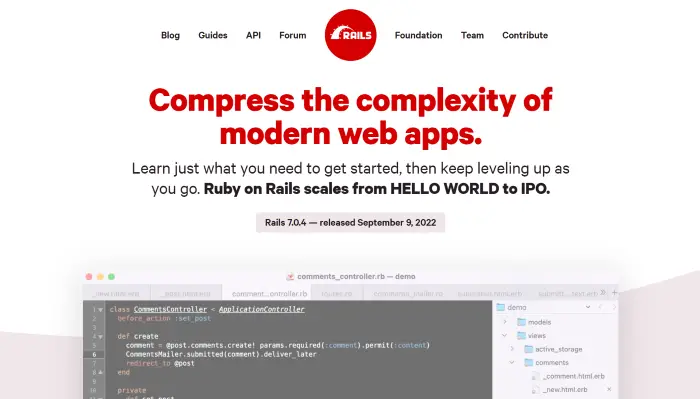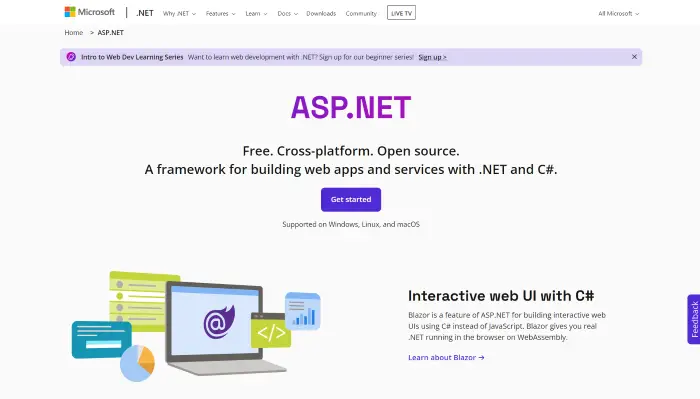Backend Frameworks for Web Development involve creating the front end and back end of a website or web application. The front end, or client-side, refers to the part of the website that users interact with directly, such as the layout, design, and functionality. The backend, or server-side, refers to the underlying structure and logic that supports the front end, such as the database, server, and application logic.
Backend frameworks provide a set of libraries, tools, and conventions for building web applications. They can significantly speed up the development process by providing a foundation of code and functionality that developers can build upon rather than starting from scratch.
Table of Contents
Best backend frameworks
The top seven backend frameworks for web development are as follows:
Ruby on Rails
A full-stack web application framework called Ruby on Rails was created in the Ruby programming language. It is known for its convention-over-configuration approach, which means that it has default conventions for things like file structure and database table naming, allowing developers to focus on building out the core functionality of their application rather than spending time on boilerplate code.

One of its main advantages is the vibrant and helpful community surrounding Ruby on Rails. It has many open-source libraries, called “gems,” that can be easily integrated into a Rails application, and many resources are available for learning and troubleshooting.
Visit: Ruby on Rails
Django
Django is a high-level Python web framework that aims to streamline the development of web applications and APIs using a pragmatic and elegant approach. It includes a built-in ORM (Object-Relational Mapper) for interacting with databases and is known for its strong security features.
It handles the hassle of web development, such as handling requests and responses, and includes a built-in ORM (Object-Relational Mapper) for interacting with databases.

One of the main advantages of Django is its robust security features, which include protection against common web vulnerabilities such as cross-site scripting (XSS) and SQL injection attacks. It also boasts a sizable and vibrant development community with access to many online materials and documentation.
Visit: Django
Laravel
Laravel is a powerful and flexible web application framework that uses PHP and the MVC architectural pattern to help developers build and maintain web applications more efficiently. It aims to simplify and elegant development, with features such as routing, task scheduling, and object-relational mapping (ORM).

Laravel is known for its expressive syntax and helpful error messages, which make it a popular choice for developers of all skill levels. It also has a large ecosystem of open-source packages and a supportive community of developers.
Visit: Laravel
ASP.NET
ASP.NET is a comprehensive web application framework from Microsoft that enables developers to build web applications and APIs using .NET languages like C# and VB.NET. It is a powerful and flexible framework that can build many web applications, from simple websites to complex, enterprise-level applications.

ASP.NET is built on top of the .NET Framework, which provides a rich set of libraries and tools
for building and deploying applications. It also integrates with Visual Studio, a popular integrated development environment (IDE) for .NET development.
Visit: ASP.NET
Spring
Spring is a Java-based framework that provides a range of features and tools for building enterprise-level web applications, including a dependency injection container, a web application framework, and an ORM.
Also, it is a comprehensive framework that provides a range of features and tools for building web applications, including a dependency injection container, a web application framework, and an ORM.

One of the critical advantages of Spring is its modular design. It allows developers to pick and choose the components they need for their precise application. It also has a considerable and active community of developers with a wealth of online resources and documentation.
Visit: Spring
Express
Express is a minimalist, fast, and flexible web application framework for Node.js that makes it easy to build APIs and other backend services. Also, its design is lightweight and easy to use. It has a simple API and middleware architecture allows developers to build applications quickly.

Express is known for its simplicity and flexibility, making it a popular choice for building APIs and other backend services. One can easily integrate with other Node.js libraries and tools with the help of Express. It also has a large and active community of developers.
Visit: Express
Flask
Flask is a microweb framework for Python design to be simple and lightweight. Making it a popular choice for building APIs and other backend services. Also, it is a popular choice for building APIs and other backend services and is known for its simplicity and flexibility.

Flask has a small and lightweight core, with many third-party libraries and extensions available for adding additional functionality. It also has a supportive community of developers with a wealth of online resources and documentation.
Visit: Flask
See also: Javascript Vs. Typescript: Which Is Better?
FAQS
Is Django fast for the backend?
Django is undoubtedly quick for the backend. Django's rapid development, built-in security features, and adaptability make it a suitable backend option for microservices architecture. Although Django projects typically scale exponentially, dividing them into minor microservices functionality is a good idea because doing so is more accessible with this framework.
Is Django a full-stack framework?
Yes, it is a full-stack framework. Django, a level web framework of Python, makes it simple to build trustworthy websites quickly. All necessary capabilities are present by default rather than as distinct modules.
What is the fastest backend framework?
The fastest backend framework is Express Js. Thanks to features like routing, debugging, and quick server-side programming, Express has proven to be the best backend framework and developer choice. It offers simple functionality, outstanding performance, and is simple to learn.
Can I use React as the backend?
Yes, you can use React in both the back and front ends. Unquestionably, React Js is a back-end JavaScript package to use in web development to make interactive parts for websites with user interfaces (UI). The creation of full-stack web apps is also possible with it.
Does Django have a future?
Due to its rising popularity as a programming language, Django has a bright future. Django is considerably more crucial because it is built on the Django programming language. It improves and strengthens the Django code, making it more durable and profitable.
Conclusion
In conclusion, these are seven of web development’s most popular backend frameworks, including considerations for top CSS frameworks. Each has its strengths and characteristics.
The right choice for a project will depend on the particular requirements and goals of the application. Choosing a backend framework well-suited to your needs can significantly speed up the development process and create a high-quality web application.
Also, explore Backend Automation Testing Tools to learn how some of your favorite websites and programs function flawlessly.
See Also: 5 Types Of Web Development Trends To Focus On In 2024
Enjoys programming, web development experience, experience in web technologies such as HTML, CSS, CSS Bootstrap, PHP, Javascript, MySQL, excellent IT skills.